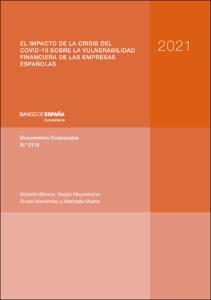El impacto de la crisis del COVID-19 sobre la vulnerabilidad financiera de las empresas españolas
Authors
Issue Date
24-Aug-2021
Physical description
43 p.
Abstract
En este documento se analiza el impacto de la crisis del COVID-19 sobre la vulnerabilidad financiera del sector corporativo español. Las simulaciones realizadas muestran que la crisis habría elevado significativamente las necesidades de liquidez de las empresas en 2020, si bien las medidas adoptadas por las autoridades nacionales e internacionales facilitaron el acceso al crédito en condiciones favorables, lo que mitigó sustancialmente los riesgos de liquidez a corto plazo. Sin embargo, la fuerte caída de los niveles de rentabilidad, unida al crecimiento del endeudamiento, se habría traducido en un aumento notorio de la proporción de compañías vulnerables (es decir, aquellas con patrimonio neto negativo o con niveles de endeudamiento elevados), que habría sido más acusado dentro de las pymes y en los sectores más afectados por la pandemia. Las proyecciones para el período 2021-2023 anticipan una progresiva disminución de estos porcentajes, en línea con la reactivación prevista de la actividad. Los resultados también apuntan a que, como consecuencia de la crisis, se produciría un incremento de entre 2 puntos porcentuales (pp) y 3 pp de la proporción de empresas con riesgo de ser inviables por tener pérdidas continuadas hasta 2023, y de entre 3 pp y 4,7 pp en la de aquellas que seguirían siendo viables pero que tendrían dificultades para hacer frente a sus deudas con sus ingresos futuros esperados (empresas sobreendeudadas). Asimismo, las simulaciones realizadas muestran que la deuda no sostenible de las empresas que habrían pasado a encontrarse en esta última situación se situaría entre los 9 mm y los 18,6 mm de euros, según el escenario considerado, concentrándose la mayor parte de este importe en el segmento de las pymes.
This paper analyses the impact of the COVID-19 crisis on the financial vulnerability of the Spanish corporate sector. The simulations conducted show that the crisis significantly increased firms’ liquidity needs in 2020, although the measures adopted by national and international authorities eased access to credit under favourable conditions, which substantially mitigated the short-term liquidity risks. However, the sharp fall in profitability levels, coupled with debt growth, appears to have resulted in a marked increase in the proportion of vulnerable firms (i.e. those with negative equity or high debt levels), which would be more pronounced among SMEs and the sectors hardest hit by the pandemic. The projections for the period 2021-2023 indicate a gradual decline in these percentages, in keeping with the expected recovery in activity. The results also suggest that, as a result of the crisis, the proportion of firms at risk of becoming non-viable on account of persistent losses through to 2023 would rise by between 2 pp and 3 pp, while the proportion of those that will remain viable but struggle to repay their debts out of their expected future earnings (overindebted firms) would rise by between 3 pp and 4.7 pp. In addition, the simulations show that the unsustainable debt of firms that have become overindebted but remain viable would stand between €9 billion and €18.6 billion, depending on the scenario considered, with the bulk of this amount accounted for by SMEs.
This paper analyses the impact of the COVID-19 crisis on the financial vulnerability of the Spanish corporate sector. The simulations conducted show that the crisis significantly increased firms’ liquidity needs in 2020, although the measures adopted by national and international authorities eased access to credit under favourable conditions, which substantially mitigated the short-term liquidity risks. However, the sharp fall in profitability levels, coupled with debt growth, appears to have resulted in a marked increase in the proportion of vulnerable firms (i.e. those with negative equity or high debt levels), which would be more pronounced among SMEs and the sectors hardest hit by the pandemic. The projections for the period 2021-2023 indicate a gradual decline in these percentages, in keeping with the expected recovery in activity. The results also suggest that, as a result of the crisis, the proportion of firms at risk of becoming non-viable on account of persistent losses through to 2023 would rise by between 2 pp and 3 pp, while the proportion of those that will remain viable but struggle to repay their debts out of their expected future earnings (overindebted firms) would rise by between 3 pp and 4.7 pp. In addition, the simulations show that the unsustainable debt of firms that have become overindebted but remain viable would stand between €9 billion and €18.6 billion, depending on the scenario considered, with the bulk of this amount accounted for by SMEs.
Publish on
Documentos Ocasionales / Banco de España, 2119
Other versions
Subjects
COVID-19; Necesidades de liquidez; Rentabilidad; Endeudamiento; Crédito; Solvencia; Viabilidad; COVID-19; Liquidity needs; Profitability; Indebtedness; Credit; Solvency; Viability; Teoría monetaria; Política monetaria; Financiación de la empresa; Instituciones crediticias de depósito; España
Appears in Collections:












